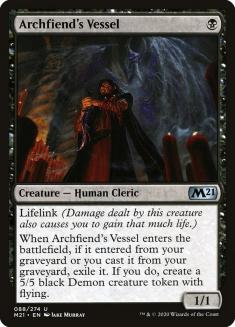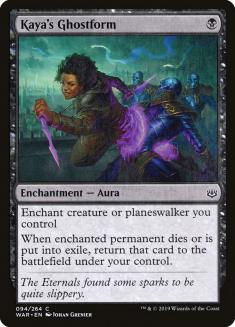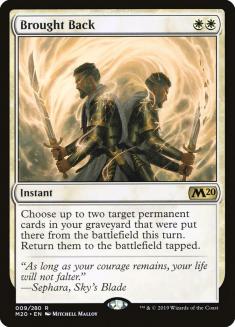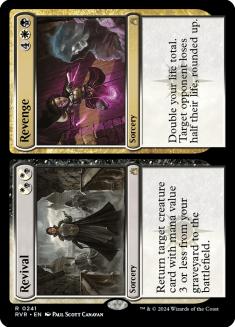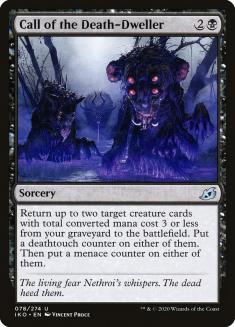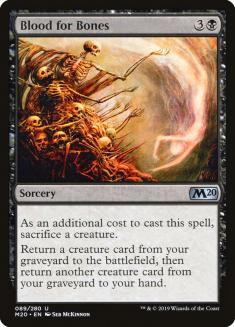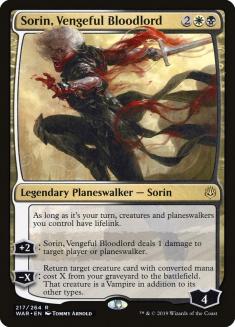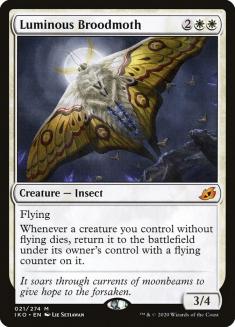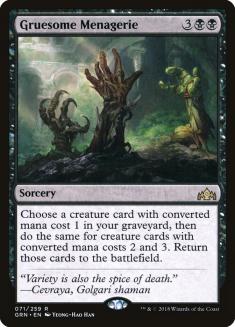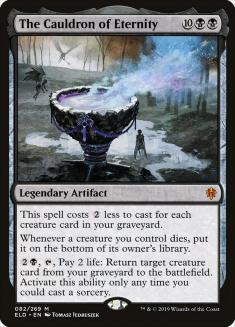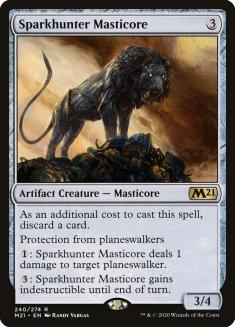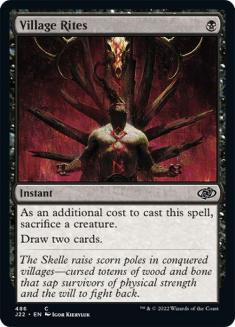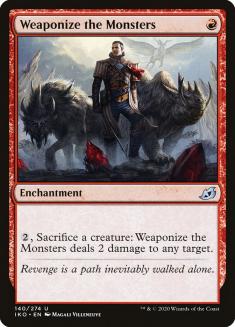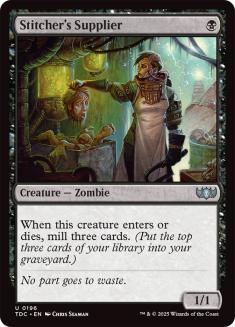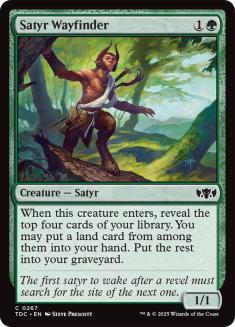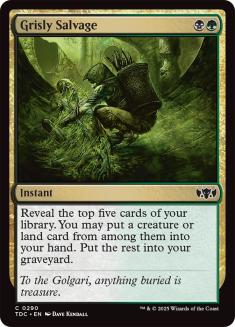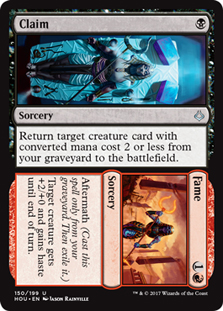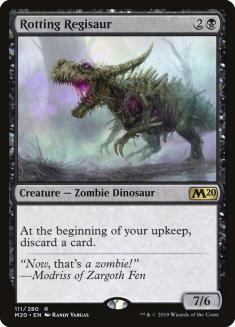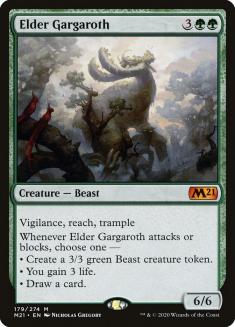Archfiend’s Vessel falls somewhere between reanimation target and value one-drop. By itself it doesn’t provide any value when it enters the battlefield or dies, but since part of its mission involves spending some time in the graveyard, you’ve gotten some value in that you’re one step closer to a 5/5 flyer. As a reanimation target in the traditional sense, a 5/5 flying creature token is underwhelming; however, since Archfiend’s Vessel can be cast as a one mana creature and has a converted mana cost of one, it’s unusually easy to get it into or out of your graveyard.
More than a value card, this is a “quest” card like Quest for the Gravelord from the original Zendikar – basically a build-around, with the note that there are multiple steps to this card’s journey, so it’s particularly prescriptive. Immediately, this should raise some flags: more steps mean more points of failure, we must balance how many cards help accomplish each step, and we’ll also be vulnerable to not drawing the right mix. A 5/5 flying token is very easily dealt with, especially while Teferi, Time Raveler is legal, so maybe we shouldn’t be willing to build an entire deck around it, but if it’s a small piece of an otherwise strong deck, maybe there’s something here.
The basic quest is simple: “Get Archfiend into your graveyard, then bring it back.” Fortunately, those two concepts generally play well together, so we could expect to build a deck with a lot of synergies that don’t rely on this card.
Breaking the quest down, the easy part is getting this in your graveyard. There are several options:
- Mill yourself, and happen to hit Archfiend’s Vessel.
- Discard Archfiend’s Vessel from your hand.
- Cast Archfiend’s Vessel and sacrifice it.
- Cast Archfiend’s Vessel and have it die in combat or through other means.
That’s a lot of possibilities. Now the hard part is bringing it back.
In Standard we have:
This isn’t an exhaustive list; for example, it doesn’t include more expensive cards that can return any creature because there are better ways to use those and they haven’t been good enough.
The best card on this list is Lurrus of the Dream-Den, of course, and it’s incredible to think that this was designed for a Standard format before Lurrus was nerfed by the companion rule change. Despite that nerf, a Lurrus deck could still be strong enough and could definitely play this card. However, another consideration is that maybe, given the nerf, we’re better off just playing four copies of Lurrus in our maindeck. This removes the deckbuilding restriction, allowing us to run other synergistic three-mana creatures so that we can get the most out of cards like Revival, Call of the Death-Dweller, and Gruesome Menagerie.
It’s hard for me to imagine why you’d build a Standard deck with Archfiend’s Vessel that doesn’t include Lurrus either as a companion or a maindeck creature. With that in mind, let’s revisit the first part of the quest. How do we get Archfiend’s Vessel in the graveyard?
Our self-mill options in Standard are limited. In black, the best you can do is probably Mire Triton. Green offers a few more possibilities like Glowspore Shaman and The Binding of the Titans, but this isn’t a great plan by itself.
Discarding it is similarly possible, but not great. For the most part we’d be looking at cards like Thrill of Possibility, but Sparkhunter Masticore is another option.
I think casting and sacrificing Archfiend’s Vessel is our best bet, as sacrifice options have gotten a lot better in the last few years than they had been for a long time. The biggest highlights are Witch’s Oven, Priest of Forgotten Gods, and Woe Strider, but there are tons of possibilities. Village Rites is the newest option and seems perfectly serviceable, if unexciting. It’s also possible that Weaponize the Monsters deserves more respect.
Let’s look at what we get when we put this together.
Creatures (22)
- 1 Judith, the Scourge Diva
- 4 Mayhem Devil
- 4 Cauldron Familiar
- 1 Woe Strider
- 4 Lurrus of the Dream-Den
- 4 Whisper Squad
- 4 Archfiend's Vessel
Lands (22)
Spells (16)

In this deck, Archfiend’s Vessel is more of a sideshow with normal Rakdos Obosh things as the main focus, but we don’t have to go very far out of our way to get access to it and it might offer a strong additional direction.
Another card I’d keep in mind for decks like this is Gadrak, the Crown-Scourge. It’s generally strong with Cauldron Familiar and Witch’s Oven, and the Treasure tokens that it makes are good for triggering Mayhem Devil and casting Obosh, especially given the additional tax. The ability to potentially attack for ten points of flying damage is another nice perk.
Creatures (26)
- 4 Priest of Forgotten Gods
- 4 Cruel Celebrant
- 1 Woe Strider
- 1 Luminous Broodmoth
- 4 Lurrus of the Dream-Den
- 4 Whisper Squad
- 4 Selfless Savior
- 4 Archfiend's Vessel
Planeswalkers (3)
Lands (23)
Spells (8)
Sideboard

Selfless Savior is a great way to protect Lurrus, or a Demon token, or even one of your high-impact two drops. Basri Ket plays well with the low curve and especially with Whisper Squad, particularly in combination with Cruel Celebrant. I’m definitely not sure about the exact best curve or number of sacrifice outlets versus number of ways to return creatures, but I think this is a reasonable starting point.
I could see a deck like this pushing the go-wide plan slightly further and adding either Venerated Loxodon or more copies of Basri Ket. This would likely involve losing Village Rites, since it doesn’t play well with trying to build a larger battlefield.
Creatures (29)
- 3 Midnight Reaper
- 4 Priest of Forgotten Gods
- 4 Gilded Goose
- 2 Cauldron Familiar
- 4 Mire Triton
- 4 Fiend Artisan
- 4 Lurrus of the Dream-Den
- 4 Archfiend's Vessel
Lands (24)
Spells (7)

The green splash here is very light, just Gilded Goose and sideboard cards. This could easily not be worth it and the purpose here is as much to show how you can build around Gruesome Menagerie as to explore Golgari. Green is a reasonable pairing because Gilded Goose helps make casting Gruesome Menagerie more realistic. Going further in this direction, we might also want to consider Llanowar Visionary, but it’s weird with so few cards that cost more than three. Going in the other direction, it would also be easy to play a different creature like Serrated Scorpion or Whisper Squad in place of Gilded Goose for a mono-black version.
Archfiend’s Vessel in Larger Formats
Moving to larger formats expands our options for Archfiend’s Vessel considerably without adding anything that invalidates the card by doing what it’s doing better. In Pioneer, finding Archfiend’s Vessel using self-mill becomes a much more appealing consideration thanks to Stitcher’s Supplier, Satyr Wayfinder, and Grisly Salvage. We also gain access to Claim, which is the best way to make the 5/5; Claim also plays well with self-mill, as we can take advantage of randomly milling Fame.
Creatures (22)
- 4 Deathrite Shaman
- 4 Satyr Wayfinder
- 4 Stitcher's Supplier
- 2 Kroxa, Titan of Death's Hunger
- 4 Fiend Artisan
- 4 Archfiend's Vessel
Lands (22)
Spells (16)

Claim is great here with either Archfiend’s Vessel or Fiend Artisan, and having both of those cards is great, since Archfiend’s Vessel will be a good target early in the game or when your graveyard is small, whereas Fiend Artisan will be a good target late in the game or when your graveyard’s stacked.
Village Rites looks outstanding here, as we’re more about self-mill than going wide, so low-cost, high-payout, single-use sacrifice is better than trying to take advantage of an engine that allows for repeated sacrificing, and between Stitcher’s Supplier, Satyr Wayfinder, and Archfiend’s Vessel, we should never have trouble finding something to sacrifice. This also helps address a common problem I run into in Pioneer: having to go too far out of my way to get full value out of Stitcher’s Supplier without Carrion Feeder to sacrifice it to. With so many strong self-mill cards, this deck is well-prepared to take full advantage of Deathrite Shaman and Kroxa, Titan of Death’s Hunger.
The danger is that the further back we go into older and larger formats, the stronger and more prevalent graveyard hate we can expect. This means we might want to consider having the option to switch gears to play high-impact threats that don’t use the graveyard against graveyard hate. This might require losing access to Lurrus, but I could see using a card like Rotting Regisaur or even Elder Gargaroth to transform into a deck that punishes hands that only interact with the graveyard.
Moving back to Modern, we potentially gain dredge cards to fuel self mill, but I don’t think Archfiend’s Vessel is the right payoff for an actual Dredge deck. We also gain Unearth. If we were to try to use this in Modern, I think the best option would be with Seasoned Pyromancer and Unearth, but I’m somewhat skeptical that this is really what that kind of deck needs.
I think Archfiend’s Vessel’s best chance to shine in a deck that really makes great use of it is in Pioneer; however, I think it’s more likely to see play at all and more likely to see play widely in Standard, where it’ll be more of an incidental inclusion in decks that happen to be able to take advantage of it rather than the true focus of a deck the way it can be with Claim and strong self-mill creatures in the format. That seems like a weird distinction, but I think it’s an interesting observation.
It’s worth noting that the applications of Archfiend’s Vessel with Lurrus are really obvious, and the Vessel made it through development with full-powered Lurrus in Standard, so we can conclude that Play Design believed that wasn’t too strong, which bodes poorly for the card in a world where Lurrus is so much weaker.
Still, there are two reasons I wouldn’t write off the card. The first is simply not trusting Play Design given their recent printings, but the more interesting reason is that the world is just so different now from the way it would be with full-powered companions. Maybe everyone in their expected format played a lot of graveyard hate because Lurrus was expected to be widely played, and maybe there will be much less and this card will be stronger as a result. Perhaps the fact that Lurrus could be a companion without an additional tax meant that they never tried building Lurrus decks where it was just a maindeck card instead of a companion, and maybe a non-companion Lurrus deck is the best home for this card.
Archfiend’s Vessel may just take flight in Standard after all.


